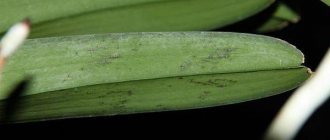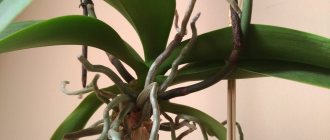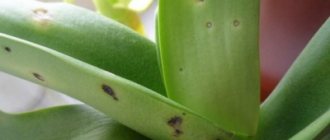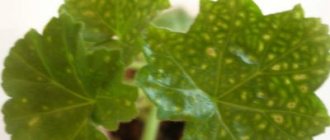Problems with leaves: why they wither, where the spots come from
Healthy orchids have dense green leaves that are quite large in size. If the leaves of a plant have changed color and structure, this indicates a disease of the plant.
Why do leaves lose their elasticity (turgor)?
Turgor - loss of leaf elasticity - the result of various errors in care
There may be several reasons:
- Temperature too high. When the plant is exposed to the sun for a long time, the leaves actively lose water. The soil also heats up and evaporation forms in it . The underground roots do not have enough moisture, and, oddly enough, they become overcooled, since the heat of the soil is spent on evaporation.
In order for the plant to be rehabilitated, it must be protected from direct sunlight, while providing enough daylight.
After the temperature between the roots and leaves has normalized, you can water or wipe the leaves with a damp cloth. You can add a little orchid to the water
- Hypothermia. When choosing a place for a plant, be sure to beware of drafts: they lead to freezing of the leaves. For an orchid, frostbite will occur at temperatures below 15 degrees.
It will not be possible to cure it; you will have to cut out the damaged tissue. To avoid such unpleasant consequences, place the flower away from drafts, and in frosty winter, place it further from windows.
- Pests. Mites and mealybugs may appear on the leaves , it withers, and the leaf loses its hardness and color.
Washing the plant from the outside will help solve the pest problem. Thoroughly clean the surface of the leaves to remove pest eggs.
Sticky leaves are a direct sign of spider mites.
If the orchid is occupied by a spider mite, then you can get rid of it by increasing the air humidity : place the pre-watered flower in a plastic bag. However, in this case, protect the orchid from the sun, otherwise harmful evaporation will occur.
The mealybug feeds on plant sap. In addition, it injects poison, poisoning the orchid, and its habitats become sticky.
What to do to save an orchid from a pest? First, you need to isolate it from other flowers . Then remove the scale insect from the surface and apply insecticides to the cleaned leaves.
Don't rely solely on chemical exposure: mites and other pests quickly adapt. Fight them comprehensively.
Preventing a flower disease is always easier than treating it later. Therefore, it is imperative to inspect the flower daily in order to stop the proliferation of the pest in time.
- Lack of moisture. The main rule for watering an orchid is to water only dry soil . Watering is best done by immersing it in water for one hour.
The composition of the substrate influences the degree of flower moisture. Unsuitable bark will not absorb moisture, and water will not be able to stay in the plant. In this case, the plant must be transplanted into a good substrate.
For orchids, bark from cut logs or dead pine, or any coniferous species is suitable. There should be no resin in the bark.
How to normalize care?
A sick plant requires special attention. Normalization of care may take some time, so be patient:
- When the first noticeable spots appear, the orchid should be immediately quarantined so that it cannot infect healthy plants. She needs to be kept in isolation until she recovers completely.
- Carefully monitor the temperature and humidity levels (at least 60%) in the room.
- Adjust the watering regime, avoid overmoistening the substrate. Be sure to spray the plant.
- Inspect the plant every day to identify the emergence of new symptoms or the fading of old ones.
- Create sufficient lighting conditions for phalaenopsis. Place the plant close to the window, but avoid direct sunlight. If you don't have enough daylight, use fluorescent lamps.
Why do phalaenopsis flowers dry out?
The reasons for the short life of a flower or bud may be the above-mentioned problems with leaves: pests, incorrect temperature conditions and watering conditions for the orchid.
Placing an orchid in the sun is a direct violation of the temperature regime, which has a bad effect on the flower.
We have already found out what needs to be done to cope with these problems. However, a number of features should be highlighted .
| If an orchid has been blooming for a long time, it may simply fade and go into a dormant period. | This is a normal process and there is no need to worry |
| Pollination of a flower by flying insects | If pollination fails, the flower will wither and fall off |
| Being near vegetables and fruits | They secrete substances that activate the ripening of flowers, even those that have not yet opened. This provokes the death of inflorescences |
| Artificial heating | Hot air dries out flowers and unopened buds. In this case, place the plant away from dry air flow |
| Stress | If the orchid was recently brought from the store, the flowers may wilt due to stress. The plant could have been poorly packaged, especially in cold weather: an orchid can drop its flowers even at zero temperatures. |
Therefore, when purchasing, be sure to protect the flower from the cold. Flowers should also be protected from the bright summer sun with a simple paper bag.
What is the danger of sticky residue?
Any disease weakens the plant, making it susceptible to other infections. For example, a white sticky coating on an orchid caused by scale insects is a favorable breeding ground for the development of sooty fungus (black fungus). Pathogenic fungal microflora clogs the respiratory openings of the leaves, completing the destructive effect of felt insects.
Pests will not stop at one plant; their colonies spread throughout all home flowers, sucking out the juices from them, which ultimately leads to very sad consequences for the home flora.
What other problems can the leaves develop?
Dark spots or dots: what to do
What diseases are indicated by darkening of the leaves of the plant?
Hives. Dark lesions appear almost immediately after infection. They are small (up to 3 mm), round in shape. They quickly spread throughout the flower. The reason is low temperature, excessive humidity , and insufficient ventilation.
Bacillus Cypriped or Brown Rot. A dangerous, common disease of orchids. Caused by a pathogenic bacillus. A favorable environment for its reproduction is high temperature and humidity. At first the stain is small and light, then it darkens and smells unpleasant.
Black rot, like any other type of rot, threatens the plant with death
Black rot (Phytophthora) is one of the most serious diseases that affects orchids. First, purple spots appear on the leaves, which gradually darken and turn black. This disease occurs due to excessive watering and too dense soil.
Phyllosticosis. The infection affects the leaf blade, which dies . Phyllosticosis manifests itself in different ways: from small black spots to large black spots.
Burkholderia gladioli. A bacterial disease that occurs at high temperatures and high humidity. Decay occurs very quickly. It appears as dark brown wet spots.
The same fungus can be individually expressed on a certain type of orchid. The manifestations of the vital activity of the fungus depend on the quality of the leaves and on the systematic care of the plant.
In addition, several pests can simultaneously develop .
White spots on leaves
If the leaves begin to turn white in spots or spots, this may occur for the following reasons:
Excessive watering. Upon contact with water, white spots form on the leaves. Nothing can be done about this; the spots will remain on the leaves.
Burn or excessive dryness. These reasons lead to the appearance of wet white spots. Damaged leaves must be removed.
White spots on the leaves are one of the signs that the plant has been attacked by a fungus
Fungal disease. It appears as white spots, similar to a burn. Fungal diseases can only be fought with special means . With timely measures taken, the plant can be rehabilitated.
Black leaves
In addition to the damage already described by fungal diseases, the leaves may turn black and die. Why might this happen?
- Some types of orchids, after the flowering period, shed their leaves, which first turn black.
- Incorrect temperature and watering conditions for the orchid
- The leaves of the plant can be infested by mites; they are often located on the inside of the leaves.
Loss of leaf elasticity and density
Loss of leaf turgor is characteristic of problems with roots:
Overheating of roots and excessive or insufficient moisture. In this case, leaf turgor is not maintained, and the orchid will begin to fade.
Remember - even special fertilizers can be harmful in high concentrations
Incorrect feeding. Don't overdo it with fertilizers . Orchid roots are very sensitive; excess nutrients are detrimental to the orchid.
The soil is too dense. If the orchid is not replanted for a long time, the soil becomes compacted and oxygen access deteriorates.
Causes of white spots on orchid leaves
There are several reasons why white spots and plaque may appear on orchid leaves - these could be:
- Incorrect irrigation system
- The result of the vital activity of pests that have settled on a flower,
- Indicator of the presence of pathogens of fungal diseases .
Excessive moisture
One of the most common reasons for the appearance of this kind of spots is incorrect organization of watering - firstly, it was carried out incorrectly technically, and secondly, perhaps the flower was watered too often or abundantly , which could lead to such disastrous results.
Immersing the tips in water when bathing the plant
In order for the orchid to remain healthy and its green mass to look aesthetically pleasing, it is necessary to create favorable conditions for its development, among which proper watering plays an important role .
The flower pot is immersed in water at room temperature and kept in it until the bark absorbs a sufficient amount of water.
It is important to ensure that the tips of the leaves are not immersed in water , because as a result, white oval spots with a hole in the middle may form on them, which will undoubtedly spoil the overall aesthetic effect.
White spots with a black border - as a result of the plant drying out
If the orchid is kept in a room with insufficiently humid air for a long time , watering is carried out untimely and in small quantities, white spots with a black border may form on the leaf blades.
Such a symptom should make it clear that the irrigation system should be adjusted and the air humidity should be increased immediately.
Important! It will not be possible to restore the aesthetic appeal of the leaves even if measures to change the conditions of the flower are taken very quickly. But we can say for sure that this will allow the grower to learn the necessary lessons and be more attentive in the future.
Infection with fungal diseases
Another possible cause of white plaque on a leaf is the fungal disease powdery mildew . This disease manifests itself in the form of a loose white coating on the leaves and buds , sometimes on the stem or peduncle.
In this case, you should immediately begin treatment with colloidal sulfur or other fungicides containing sulfur compounds that will help cure the plant.
Important ! The indirect cause of the rapid development of powdery mildew pathogens is dry air, so it is very important to ensure that the humidity and frequency of watering correspond to the level required for the orchid.
Mealybug
Also, the cause of white spots can be a pest mealybug . These are small insects measuring 3-6 mm. The pest leaves a specific white discharge .
To combat it, you can use folk remedies or chemical insecticides .
Folk remedies are like this:
- Option 1: prepare a solution of laundry soap at the rate of 10 grams of soap per 0.5 liter of warm water and add a teaspoon of alcohol. The resulting solution is wiped on the orchid leaves.
- Option 2: Horsetail infusion from a pharmacy, diluted 1 to 1 with water.
- Option 3: Crush 4 cloves of garlic into half a liter of water, strain and wipe the leaves and infected areas of the orchid.
Insecticides: Aktara for the leaves of the plant, Fitoverm for treating the roots.
Problems with orchid roots: drying out
The color of the roots of an orchid depends on the specific species, fertilizers and complementary foods. Some species have naturally dark roots, but this does not indicate that they are painful.
To assess the condition of the roots, you need to carefully remove the plant from the pot, free the root system from the soil and inspect the roots. If they are firm, they are healthy. If the root seems hollow inside, it dried out irrevocably .
Orchids have two types of horses: aerial and underground (internal). Underground are found in the substrate. Aerial roots are those that are located outside the soil. This is the norm for an orchid.
Aerial roots are important for the proper photosynthesis process of the orchid.
Causes of drying out of underground and aerial roots
- Chemical burn from hard water and fertilizer salts.
Incorrect watering. Why roots dry out when there is not enough water is obvious. If you keep the root system in constant moisture, the roots will die and, oddly enough, they will dry out or rot.
- In most cases, white roots indicate that the plant was mercilessly flooded with water and is not participating in photosynthesis.
- Dry air.
- Injuries. The roots are easy to break . Even a minor scratch will cause the root to dry out.
- Life activity of fungi.
Prevention measures
To prevent the appearance of third-party spots on phalaenopsis leaves, you need to follow standard preventive measures:
- Provide the plant with proper watering (apply a new portion of water only when the soil is sufficiently dry).
- Daily temperature changes in the room should not exceed 4-5 degrees. If the temperature drops below 15 degrees, the plant will die.
- Daylight hours for an orchid are 10-12 hours. The light must be diffused.
- Fertilize a couple of times a month.
- Choose only high-quality soil for phalaenopsis, which contains tree bark, moss, peat and river sand. Be sure to provide the plant with adequate drainage.
Caring for an orchid can be very difficult. Even experienced flower growers face difficulties, let alone beginners. One of the most common problems is the appearance of third-party spots on the leaf blades of phalaenopsis. This defect may indicate improper care, the presence of pests or serious diseases in the plant. So don’t delay your examination and treatment.
What to do with soft and limp roots
As soon as a gardener is faced with sluggish and soft phalaenopsis roots, the question arises - what to do? Below we provide step-by-step instructions:
- Free the plant from the substrate.
- By placing the plant in water, it will become clear which roots or parts thereof have dried out. All dead areas are cut back to the living root. Treat the cut area with cinnamon or charcoal .
- To help the flower produce new roots, prepare warm, soft water. You need to place an orchid in it. Repeat the bath every day, leaving the flower in the water for an hour. After moistening, be sure to dry the orchid.
You can use succinic acid, which stimulates root growth . As an alternative, use Epin or other growth stimulants in low concentrations.
- After the new roots reach a length of 5-6 cm, the flower is placed in a pot with a substrate.
Don’t be afraid to try to prepare the substrate yourself - the main thing is to follow the proportions.
To prevent diseases from occurring on your orchid, just follow three simple rules: keep the flower in a bright place, monitor the air temperature and follow the watering regime. The rules are very simple ; if followed correctly, the plant will delight you with regular flowering and health.
What to do?
If the cause of spotting is improper care, correcting the conditions will quickly bring the plant back to a healthy state. When time is lost, bacteria, fungi, viruses destroy the flower, then it’s time to take serious measures.
Reanimation
Action plan:
- The orchid has lost its leaves and growing point, retaining only the stump with a root collar and rhizome - plant it in a fresh substrate in a mini-greenhouse. Without spraying, with moderate watering.
- The leaves are completely or partially lost, 2-3 roots remain, the stem has a growing point - plant it in fresh soil, use spraying instead of watering.
- The peduncle is preserved without a growing point, horses, leaves - divide into segments of 2-3 cm with a dormant bud. Place on the surface of moist sphagnum moss.
Treatment of Phalaenopsis flower with drugs
Action plan:
- Isolate the orchid and rinse in warm water.
- Wipe the leaves dry with a napkin or cotton wool, especially in the area of the spots, to remove the coating of spores.
- Remove affected areas to healthy green tissue.
- Disinfect the cut area with charcoal or brilliant green.
- Use a fungicide that targets a specific fungus (Benomyl).











